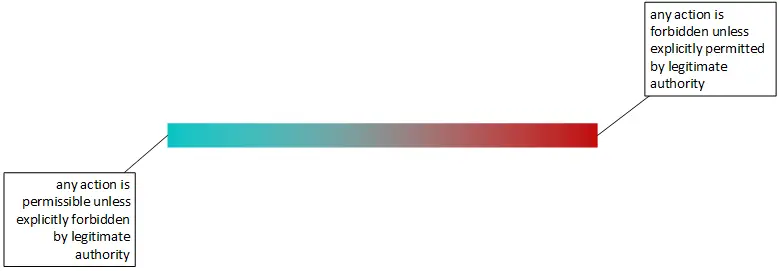Holacracy Basics: Understanding Accountabilities
Accountabilities are allocations of attention.
Accountabilities are allocations of attention.

Accountabilities are one of the three parts of a role and are the most common (the others are Purpose and Domain). To cover ground quickly, here’s what you need to know…
The constitution defines accountabilities as a role’s “ongoing activities,” which is why the first word in accountability is always a verb ending in “-ing” (e.g. “Implementing…” “Designing…” “Executing…”). And this is true regardless of the scale or scope of the work. In this sense, an accountability basically means, “The work a role is supposed to do.” Here are some examples:
But there’s a caveat to this. Because even though we can generally say an accountability is the work a role does, it doesn’t mean you’ll actually do it — just that you’ll regularly consider doing it. Why is that?
Well, it’s because accountabilities are a construct in governance, and governance, by definition, is just giving you a map of expectations, authorities, and restrictions (To learn more about governance read this). So, in a way, an accountability is really…
As a form of governance, an accountability means you’re expected to dedicate some time and attention to considering the defined work, but it leaves the question open of whether or not you’ll actually do it. In other words, it breaks the question, “What should I do?” into two separate questions:
Let’s look at each.
Accountabilities tell your role what to pay attention to. It’s as if we’re all on guard duty and an accountability is essentially saying “Watch this zone,” or, “Care about this zone.” So, an accountability for “Maintaining financial records,” means that role cares about anything related to bookkeeping and others, knowing you’re doing so, can more easily watch their zones (i.e. if I know you’re covering the back door, then I can be more fully present to guard the front door).
Accountabilities are defined in a circle’s governance meetings (i.e. a role cannot create its own accountability outside of a governance meeting), meaning they come from the team level. So, day-to-day everyone is doing what they think is best, but they aren’t only doing that.

They are also using governance as a shared playbook of expectations and responsibilities. And there isn’t a single individual determining who does what — the group decides what the playbook looks like by processing their tensions one at a time. So, with the playbook of who-does-what defined, each individual can use their best judgment day-to-day.
Now, having defined the parameters of our attention, what do you actually do? Ah! Good question. But interestingly, accountabilities don’t answer it for you.
That’s because it’s really a question of one’s available time, energy, context, and prioritization. And while Lead Link’s are accountable for defining priorities, the other stuff can’t really be defined for you.
Think of it like this — you could say a human being has accountabilities like, “Eating,” “Working,” and “Sleeping,” but as adults, each of us can figure out for ourselves when and if we do those activities. It’s really more of a moment-to-moment thing.
So, once you’ve been giving your marching orders from the circle (i.e. your accountabilities), what and when you actually do those things is a question you answer for yourself operationally. You can do this because…
Regardless of how an accountability is defined, the constitution always gives you the full authority as the role-filler to use your interpretation (§3.4). Actually, let me say that again…
YOU HAVE THE FULL AUTHORITY AS THE ROLE-FILLER TO USE YOUR INTERPRETATION TO ENERGIZE YOUR ROLE’S ACCOUNTABILITIES.
I emphasize this because whenever we are dealing with language, we are dealing with issues of interpretation. And we can’t possibly have perfect clarity.

Instead, through governance, we get enough clarity to keep things moving. And should conflicts of interpretation arise (they will), Holacracy provides pathways for dealing with them (i.e. ask the Secretary for a temporary ruling [§3.4.1], and/or just propose a clarification in governance).
Say you have an accountability like, “Notifying suppliers when orders change.” Well, that could mean you take two minutes to send an email, or it could mean you take several months and spend $15,000 developing an automated system. There isn’t just one interpretation.
Which is why…
Since accountabilities are open to the role-filler’s interpretation, they don’t necessarily allocate any specific amount of time, energy, or money. How long would it take you to energize an accountability like, “Publishing a newsletter?”
We can’t know. There is no objective standard. It could take an hour or a year. This is important to understand especially during governance meetings when objections like, “We don’t have time to do that,” get raised. This isn’t a valid objection because an accountability doesn’t allocate resources.
It’s just an allocation of attention. This is why a Facilitator might ask, “Given infinite time and money, would you still have this objection?” Usually, the answer is, “No.”
Note: There are exceptions in which the answer might be “Yes.” Like an accountability phrased as “Cleaning office daily,” or “Ensuring all electronic documents are saved in at least three separate locations,” might cause the objection, “Even with infinite time and resources, it still wouldn’t make sense to try and store all documents in three separate locations. And even knowing that I can interpret this however I wish, there isn’t much room for interpretation.” Finally, if you want to understand how you should handle things like working hours rather than trying to bake them into accountabilities, then read this post.
It’s especially important to remember that “Accountabilities don’t allocate resources” when others point to your accountabilities to request projects (more on this in #5). For example, have you ever declined a project (or wanted to decline) because you don’t have time? Or because you have more important stuff to do?
Well, once again, this is conflating two questions, which Holacracy practice splits up…
This means that when someone requests a project or next action from your role, the first question you always ask is, “Does this work fit my role?” (or “Does my role care about this?”). We just want to know where the work lives and accountabilities help us do that.
Because having an accountability doesn’t necessarily mean you’ll need to dedicate some objective standard of time, money, or energy to it. In fact, it doesn’t necessarily mean you’ll ever do it. Remember, it’s really just an allocation of attention. You just need to consciously consider doing it.
Imagine your Designer role has a project for “New logo designed,” but later, having never taken any action on the logo project, you learn customers have become attached to the current logo and it makes sense to keep it. Would you keep the logo project? I hope not. Meaning, even though you agreed it fit your role, and you tracked it on the circle’s project board, nothing ever happened with it.
Again, just because you track a project doesn’t mean you’ll do it. Of course, it doesn’t mean you won’t either — it just means it’s one of the many things you have to choose from. But if you never wrote it down, how can it ever get prioritized relative to everything else?
Lastly, remember that accountabilities don’t allocate resources (#4). So, even if an accountability said “Spending money on parties,” by definition, it’s not granting the authority to do that — it’s simply defining which role “cares” about that function. Note: The authority to spend money is tricky to explain. For now just remember the authority to spend money, by default, belongs to the Lead Link of the largest circle in your organization and cascades down from there.
Remember, an accountability just allocates attention to specifically-defined ongoing activities. And with that knowledge in hand, we can self-organize and coordinate our work, because…
Note: If you want to learn more about how projects work in Holacracy practice, read this.
Accountabilities are a way to operationalize expectations. Specifically, when your role has an accountability it means two things: 1) you’re expected to proactively energize it, and 2) others can expect you to take on work based on it. Again, let’s look at each of these elements independently.
According to the constitution, whenever you fill a role with accountabilities, any role, you’re agreeing to:
So, whenever you agree to take a role, you’re also agreeing to be obligated by these general expectations (don’t worry about remembering them all — that’s why we write them down).
Now, in addition to proactively considering how to energize your accountabilities, others can now reference your accountabilities to request things from you. In this way, an accountability is almost like a contract or agreement.
So, if you have an accountability for “Developing websites and registering domain names,” and I ask you to take a project like “Landing page created for the new FAQ,” then I can expect you’ll take it.
And this is one of the most powerful ways Holacracy practice can transform the way you work. Because it’s as if you and I got together and made an agreement — you said, “Hey, in the future, should you ever need me to develop a website or register a domain name, just let me know for it would be my deepest pleasure to do so,” and I said, “OK, cool. You rock!” So, when it comes time to request that website, I don’t need to butter you up or beat around the bush. I can just ask.
To get a feel for this, imagine you’re a server in a fancy restaurant and when you ask for a customer’s order they say, “Oh, right…so sorry, I don’t know if it’s possible…and I don’t want to be too much trouble, it’s just that I’ve had a long day, and again, I hate to be a pain or an inconvenience, but if you have time…and you don’t mind…could I just maybe possibly get a glass of water?” You’d probably want to slap them.

You’ve already agreed to be a server. It’s not like you’re doing them a favor. You just want to do your job. That’s what it feels like when you’ve made a previous agreement. We can just get on with things. We’ve already agreed to energize our roles, so why all the sweet talk? I just want to know, “What do you need?”
And since accountabilities don’t necessarily allocate resources, and since tracking is different than doing, when someone requests a project from you, DON’T ask yourself, “Do I want to do it?” or “Do I have time to do it?” or even “Is it important to do?”
Those are important questions. But ask them later. First, ask yourself, “Does it fit my role’s accountabilities (or purpose)?” If it does, put it on your project list. Then figure out where it might fall in your priorities.
Or, if you want to request something from someone else, ask yourself, “Who has already agreed to work on stuff like this?” Or, “Who has the authority to make this decision?” And how would you know the answer? Look at the role’s accountabilities (or purpose).
Of course, it’s very likely, especially at the beginning of your practice, that you’ll find gaps in your governance. In these cases, you need to know…
For example, you want someone to get new office chairs and the “Office Furniture” role will tell you, “Not my accountability.” Or, a customer makes a special request, but it’s not clear who has the authority to grant it. That’s OK. Because roles and accountabilities are just the starting point.
For example, let’s say your circle has a lot of complex metrics to go over, and managing the data during the meeting is too time-consuming. Someone needs to locate software to fix the issue and you’re the only one on the team with that expertise.
The temptation at this point is to ask, “Should I do it?” or “Do I have time to do it?” But they are the wrong questions to ask. Instead, remember the first question to ask is, “Who has ALREADY agreed to work on stuff like this?” Who is accountable?
Is it the Facilitator? The Lead Link? The Secretary? Nope, nope, and nope. Ah! Now, before we move on to solving the issue operationally, we’ve learned something and that needs to be captured. So, first things first. You (or anyone else who notices the gap) record a tension for the next governance meeting, and by doing so, you’ll be building the organization’s capacity. So, hopefully, you won’t have to revisit the question “who-cares-about-this-kind-of-work?” again. Go you!

With that done, now ask yourself, “Does anything need to be done operationally before that governance meeting?” And if so, do it! It’s that simple. And since it’s not in a role, you’d simply ask the Secretary to record it as “Individual Action,” (§4.3) which essentially means the work is outside of your current roles, but it’s still something that the circle or the organization in general cares about.
So, now you’ve done two things. You’re dealing with the longer-term issue of clarifying accountability via the governance process AND you’re also dealing with the short-term operational issue.
If you’re new to Holacracy practice, it’s easy to assume that because we spend so much time asking about roles (e.g. “What ROLE are you speaking from?” or “What ROLE are you engaging?”) that you’ve done something wrong if you don’t know the answer. But these are clarifying questions. Not judgments. Not knowing the role, or finding a missing accountability is fine. The point is we don’t stop there.
So, finding gaps is a natural part of the practice. And since every change needs to be driven by a felt tension (i.e. it can’t be purely intellectual), we only fill the gaps we need to. So, it’s important to remember…
The most common misconception about accountabilities is that they give you permission to do things. They don’t. The confusion arises because permission works differently in the conventional management hierarchy than it does in Holacracy’s rules.
Essentially, the default assumption for conventional organizations is, “Any action is forbidden unless explicitly permitted by legitimate authority,” versus the Holacracy approach, “Any action is permissible unless explicitly forbidden by legitimate authority.”

With this in mind, it’s easy to understand why one would assume they need an accountability for, “Assigning conference rooms upon request,” in order to do so (or prevent others from doing so). But actually, if you want to prevent others from doing something, you want a policy, and if you want to give a role exclusive control over something, you want a domain.
Without a policy or domain, technically speaking, anyone can assign conference rooms. But is that a problem? Maybe not. If you’re the only person with admin access to the room reservation system, then even though technically the rules allow it, it doesn’t matter. In reality, no one else can do it.
And this is why it’s important to remember accountabilities should always be “tension-driven.” If you already consider something like “Assigning conference rooms upon request,” as part of your Operation role’s purpose, then you don’t need the accountability.
The symptoms of this misconception are fairly clear. Like having roles with long lists of highly detailed accountabilities. Often this is done because it’s assumed the accountabilities need to specify everything the role might need to do. But again, that’s not how they work.
This confusion sometimes occurs because when we colloquially say a role “cares,” or that practitioners should “own their roles,” it may seem like an accountability is “work you exclusively own.” But in Holacracy, remember, the exclusivity of control is defined using domains — we say “own your role,” as a convenient simplification of the expectation to be proactive, described in #5.
Another common example is when someone consistently proposes adding new accountabilities to their own role. As if to communicate to others, “Back off! These are my areas!” In this case, let’s look at the example of someone else doing something you’re normally accountable for.
Say, you’re accountable for “Emptying the trash cans,” and Cheryl decides one day to go around emptying them (Cheryl is weird like that). Now, your first instinct might be to take offense. After all, she basically saying you’re not doing your job, right!?
Well, actually, probably not. Cheryl is feeling a tension and she is taking action to solve it. That’s it. If anything, she is helping your role fulfill its purpose. Even if she knows your role is accountable, she thinks it just makes more sense to do it herself.
So, we don’t want to prevent someone from taking care of themselves. If your Sales role needs a custom brochure for a potential new client, but the Marketing role is accountable for, “Designing sales brochures,” that shouldn’t stop you from creating it yourself. If you’re willing and able to do it yourself, then the only question to ask is, “Is there a domain or policy that prevents me from doing this?” If not, go for it! And instead of assuming the worst, trust that others will process their tension on the off chance your action created one.
Accountabilities are many different things. They are “the work a role does,” “ongoing activities,” “allocations of attention,” and “defined expectations.” They are like a shared map of expectations and responsibilities, defined at the circle (i.e. team) level, but always open to individual interpretation and application.
Read “Introducing the Holacracy Practitioner’s Guide” to find more articles.
To learn more about self-management, join a community of pioneers and check out our e-courses → Self-Management Accelerator
